|
 |
Newsletter
Fall 2016
|
|
 |
| |
|
Maryland 2017
Composting Demonstration Site and Training Workshops
We are thrilled to announce that Veteran Compost, LLC of Aberdeen, Maryland - in partnership with O2Compost – has been awarded a two-year grant with the Maryland Department of Agriculture to train livestock owners how to properly manage livestock manure using the Aerated Static Pile Method of Composting. The goal is to work with livestock owners throughout the Chesapeake Bay Watershed and teach them how to protect surface and ground water resources.
The grant proposal includes three components:
|
- A demonstration site near Annapolis, Maryland that utilizes ASP Compost Systems that are suitable for small, medium and large scale livestock operations;
|
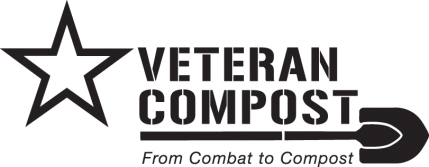 |
 |
- Workshops to teach livestock owners the science and art of composting; and
- A website that helps producers market and sell their compost to gardeners, landscapers, urban farmers and others located throughout the State of Maryland and neighboring region.
The demonstration site will be a permitted, working compost facility that illustrates cost effective strategies for converting a significant waste problem into a resource opportunity. The facility will utilize solar power as an alternative energy source, and will demonstrate water conservation strategies through the capture and reuse of rainwater from structure roofs.
With assistance provided by local universities and county conservation districts, this project will also conduct research to study the sequestration of nitrogen and phosphorous to reduce adverse impacts to surface and ground water resources in the Chesapeake Bay Watershed.
Workshops will be conducted on a quarterly basis beginning in March 2017, and will include the following topics presented by nationally recognized leaders in their respective fields:
- The fundamentals and practical applications of on-farm composting;
- The benefits of compost utilization;
- Small farm planning: mud, pasture and manure management;
- Vermiculture (composting with worms);
- Organic land care practices and carbon sequestration; and
- Marketing high quality compost products.
While Maryland residents will be given priority, everyone will be welcome to attend these workshops and participate in the marketing cooperative website. If this is of interest to you, email sherri@o2compost.com to add your name to our Pre-Registration List.
|
Do You Own an O2Compost System?
If you already own an O2Compost System, please contact us this fall to schedule a “well-check” consultation. We want every one of our systems to be operating perfectly as we head into winter.
With your O2Compost System, you purchased lifetime technical support, and at no additional cost to you, we are available to answer your questions, discuss any concerns that you may have, and help you troubleshoot your system.
If everything is going well for you, we’d also love to hear from you. If you have sold your farm, we are available to train the new owner how to use their compost system. If you have new employees, we are also available to train them.
Over the past 15 years, we have designed aerated compost systems for over 1,200 small farms, private and public compost facilities, and a wide range of institutions. These compost systems process all varieties of organic waste and represent all scales of operation. It is our goal that every one of these systems serves as a demonstration to other organic waste generators that these “wastes” can be easily converted into value added products for use on-site or sold into the local community.
Contact us by phone: 360-568-8085
Contact us by email: sherri@o2compost.com
|
Using Compost as Stall Bedding
One of our clients recently shared that she mixes her finished horse manure compost with wood pellets and uses it as stall bedding. I shared this information on our Facebook page and an interested reader asked to see pictures. We reached out to Terry S. in Redmond, Washington, and she kindly sent these photos to share with our composting community.
The photo on the left shows the bedding when the compost is first added. The photo on the right shows the mix after it has had a few hours to dry out. Terry also shared some details about her process that we would like to pass along:
“I’m very pleased with the results. Adding the compost has drastically reduced the dust in the barn (and thus in all our lungs as well). It is slightly softer than straight pellets and clumps the urine better. I’m told it is better for the horses’ feet as well and I believe it. I’m experimenting with a higher and higher ratio of compost to bedding and am still pleased with the results. I dumped a full wheelbarrow of pure shredded compost into each stall last night and the results this morning are good.
I should also add that I always screen the compost I put in the stalls or put it through a shredder first. When it first goes into the stall it is a dark brown color, but it dries out when mixed with the existing bedding and just slightly darkens the overall mix. After much research, I found a shredder that can handle both the compost and the occasional piece of gravel it includes, but I have to wait for the compost to dry out after removing it from the bin before I put it through the shredder. Otherwise, it just gums up the shredder and clogs the machinery. After removing the compost from the bin, just leaving the pile open to the air with a roof overhead for a couple of weeks dries out the pile enough to put it through the shredder. This whole process requires a strong back and a fair amount of work but I think it’s worth it. Now I don’t have enough compost to meet all my needs for both bedding and fertilizer!”
Thank you, Terry, for this valuable information. We hope it will encourage others to try using composted horse manure as stall bedding. What a great way to save money, improve the health of your horses, and turn waste into an environmentally-friendly product.
Check out Terry's compost system on our website.
|
International Composting
By Peter Moon
When I constructed my prototype aerated bin compost system back in 2001, I had no idea how I would offer this simple technology to the world. I had proven to myself that it would work with horse manure in Washington State, but what about Arizona (high heat), Colorado (high elevation), Edmonton (extreme cold) or Florida (high humidity)? In the back of my mind, I also wondered if the same principles would work overseas. The rational side of my brain said “of course it will”, but the emotional side wasn’t convinced.
It is now 2016 and we have helped develop compost systems throughout the United States and Canada, and in 18 additional foreign countries. I’d like to share two new systems that came on-line just this year, the first in Panama and the second in Israel.
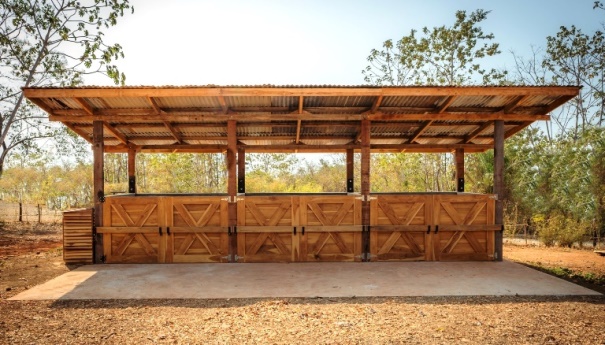
Reserva Ecologica Panamaes, Pedasi, Republic of Panama
Our "Panama Project” was designed and constructed by Ivan and Kristin M. of IM/KM Design. The system composts manure from six horses on the Reserve along with nursery scraps, wood shop scrap material, food scraps, and miscellaneous forest debris. The finished compost is used on 150 acres of reforested land as well as 1,000 acres of forest. The owners are "very happy with the unit" and have proposed the construction of a similar system in the town of Pedasi to help mitigate trash problems and create much needed compost for reforestation projects in the area.
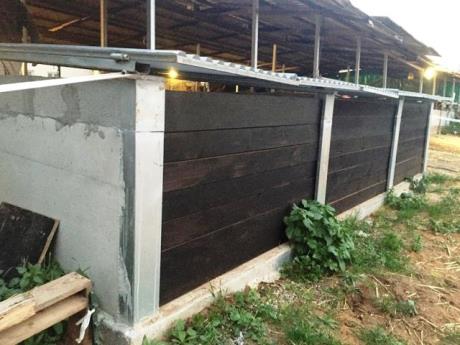
Piloni's Place, Hibbat Ziyon, Israel
Nikki K. didn't like the idea of polluting the environment with raw manure dumped "who knows where", nor did she like the idea of paying for its removal. She built her Benchmark system to handle the manure from her four horses. The finished compost is given away to several neighbors. Nikki said "I love the feeling that I'm doing something good for the environment. It does actually reduce the number of flies which is a great thing. It's neat and clean."
Location List for all our International Systems:
| Africa |
Argentina |
Australia |
Columbia |
| Germany |
Ireland |
Israel |
Mexico |
| New Zealand |
Philippines |
Panama |
Puerto Rico |
| Spain |
Switzerland |
Taiwan |
Trinidad |
| United Kingdom |
Venezuela |
|
|
|
|
Compost and Dahlias
By Peter Moon
In April 2015, my daughter announced that she and her fiancé would like to get married at our home, and she asked me to grow lots of flowers so that our garden would be full of color for the wedding in August. (Refer to “Organic Land Care Put into Practice”, July 2015 Newsletter).
The short version of this story is that I bought 50 dahlia tubers, started them in my greenhouse, dug 50 5-gallon holes throughout the garden, prepared the soil with compost and transplanted the dahlias - all before the end of May. I’m pleased to say that we had a lot of color in the garden for the wedding (which was a wonderful success, despite a record windstorm that day: trees down, no power, and many guests and the minister running 2 hours late due to traffic in all directions).
That October I was in a quandary with what to do with all of the dahlia plants. By that time, I was tired of working in the garden and instead of digging up the tubers, cleaning, dividing and storing them over the winter, I decided to take my chances and leave them in the ground. What I did do is this – I cut the stalks to about 3-inches above ground level and then I placed a 5-gallon bucket of compost over the top of each one to serve as insulation. It looked like a gopher colony all winter long BUT-IT-WORKED.
In April, I spread out the compost, added bone meal and some organic fertilizer. By June, new dahlias were blooming with a vengeance. So far this year, we estimate that we’ve cut roughly 100 bouquets and have given them out wherever we go. I’m now considered the neighborhood “Dahlia Expert” but between you and me, I give full credit to the compost.
|
|
FAQ
How are the odors controlled in an ASP Composting System?
Answer:
There are three primary means of controlling odors from a compost pile:
1. Maintaining Aerobic Conditions Throughout the Compost Pile
- When a compost pile is turned, oxygen is delivered throughout the mix of materials, however the microorganisms consume that oxygen within 20-30 minutes, returning the pile to a largely anaerobic condition. It is the by-products of an anaerobic condition that results in the production of odorous gases.
- With ASP Composting, we do not turn the pile but otherwise induce airflow into the compost pile at regular intervals. By doing this we keep the oxygen level above 10% at all times and mitigate the generation of offensive off-gases.
- All compost piles (aerobic and anaerobic) generate some odors, however the by-products of an aerobic compost pile are far less offensive (described as a mild organic odor).
2. Compost Cover Layer
- When the pile of raw feedstocks is constructed, we cover it with a 12” (plus) thick layer of finished compost from an earlier batch. This outer layer serves (in part) as a biofilter for in situ treatment of the off-gases.
- This outer layer absorbs the odorous gases and the microorganisms that reside in this layer digest the gases, thereby further reducing odorous emissions.
- This outer layer also serves to insulate the compost mix, allowing for temperatures to exceed 55oC (131oF) for at least three days and thereby destroying pathogens, parasites and weed seeds in the mix.
- In addition, the cover serves as a vector barrier, prohibiting access to flies, birds, rodents and larger wildlife.
- To function properly, this outer layer needs to be kept wet at all times.
3. Secondary Capture and Treatment
- As a back-up means of controlling odors (i.e., worst case scenario), we can cover the entire pile with an impervious tarp. We can place a perforated pipe on top of the pile / under the tarp, and evacuate the odorous gases from under the tarp with vacuum (negative) airflow.
- The captured air can then be directed under positive airflow into a secondary, stand-alone biofilter.
- This back-up approach to containing and treating odors has been fully tested for a fish waste compost operation in Washington State, and accepted as a BMP Contingency by the local air quality agency.
|
New Compost Systems Come On-Line
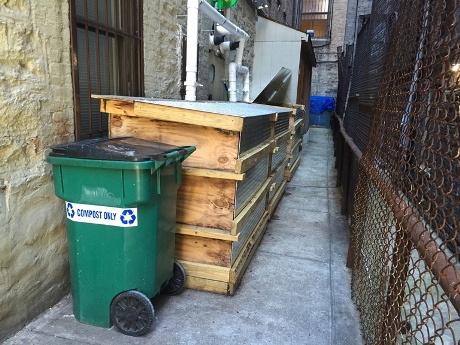 |
OWNER: Michael F.
LOCATION: New York, NY
Composting food waste from his restaurant.
More information on our website.
|
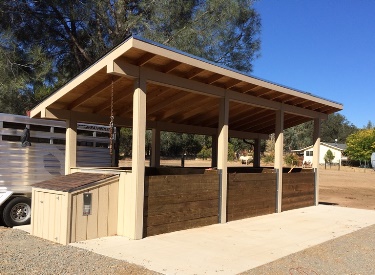 |
OWNER: Ken and Val K.
LOCATION: Spring Valley, CA
"We have the cleanest pasture in the area."
More information on our website.
|
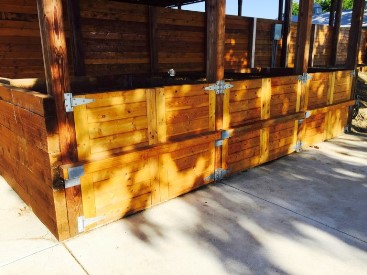 |
OWNER: Greg M.
LOCATION: Corvallis, OR
"Our finished compost is entirely free of weeds and seed..."
More information on our website.
|
|
Coming Events
October 17-21, 2016
WORC Compost Facility Operator Training
- Puyallup, Washington
For more information, visit http://www.compostwashington.org/compost-facility-operator-training-cfot-
October 20-21, 2016
North Carolina Composting Council ASP Composting Workshop
- Raleigh, North Carolina
For more information, visit http://carolinacompost.com/event/aerated-static-pile-composting-workshop/
January 23-26, 2017
US Composting Council Conference
- Los Angeles, California
Peter Moon will be covering "Advances in Small Scale On-Site Food Waste Composting"
For more information, visit compostingcouncil.org/compost2017/
2017 - Dates TBD
Quarterly ASP Workshops
- Anapolis, Maryland
|
|
Protecting Our Land, Air and Water Resources
|
|
O2Compost
Price-Moon Enterprises, Inc.
PO Box 1026
Snohomish, WA 98291
|
Phone: 360-568-8085
Email: info@o2compost.com
www.o2compost.com
|

|
|
